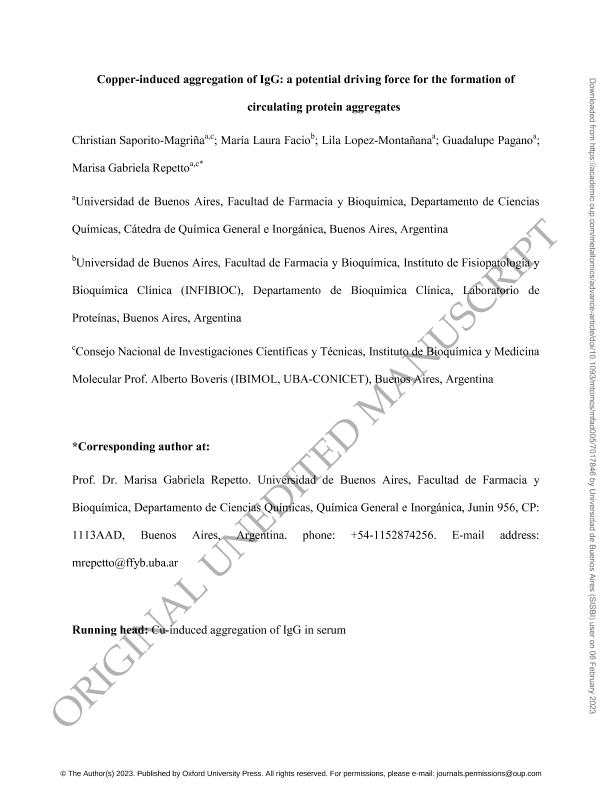Artículo
Copper-induced aggregation of IgG: a potential driving force for the formation of circulating protein aggregates
Saporito Magriñá, Christian Martín ; Facio, Maria Laura; Lopez Montañana, Lila Lucia; Pagano, Guadalupe Belén; Repetto, Marisa Gabriela
; Facio, Maria Laura; Lopez Montañana, Lila Lucia; Pagano, Guadalupe Belén; Repetto, Marisa Gabriela
 ; Facio, Maria Laura; Lopez Montañana, Lila Lucia; Pagano, Guadalupe Belén; Repetto, Marisa Gabriela
; Facio, Maria Laura; Lopez Montañana, Lila Lucia; Pagano, Guadalupe Belén; Repetto, Marisa Gabriela
Fecha de publicación:
01/2023
Editorial:
Royal Society of Chemistry
Revista:
Metallomics
ISSN:
1756-5901
Idioma:
Inglés
Tipo de recurso:
Artículo publicado
Clasificación temática:
Resumen
Copper is a highly reactive element involved in a myriad of biological reactions. Thus, while essential for mammalian cells, its concentrations must be kept in check in order to avoid toxicity. This metal participates in redox reactions and may exacerbate oxidative stress in aerobic organisms. Nonetheless, the actual driving force of copper-induced cell death is yet unknown. Likely, free copper ions may target different biomolecules that are crucial for the proper functioning of an organism. In this work, we show that free copper induces protein aggregation in serum. The wide set of proteins present in these biological samples are not equally prone to copper-induced aggregation and some, such as albumin, are highly resistant, whereas γ-globulins are highly sensitive. The identity of the proteins in the aggregates becomes fairly homogeneous as metal concentrations go as low as 20 μM. The identification of the proteins by mass spectrometry indicates a preponderance of IgG and a minor presence of other different proteins. Therefore, free copper in blood may contribute to the formation of circulating protein aggregates with a core of IgG. This may impact health not only due to the activity of aggregated IgG but also due to the many proteins co-aggregated. Understanding whether the γ-globulin core and the heterogeneous subgroup of proteins elicit differential responses in the organisms requires further research.
Palabras clave:
AGGREGATES
,
COPPER
,
IGG
,
IMMUNOGLOBULIN
,
PROTEIN
,
Γ-GLOBULIN
Archivos asociados
Licencia
Identificadores
Colecciones
Articulos(IBIMOL)
Articulos de INSTITUTO DE BIOQUIMICA Y MEDICINA MOLECULAR
Articulos de INSTITUTO DE BIOQUIMICA Y MEDICINA MOLECULAR
Citación
Saporito Magriñá, Christian Martín; Facio, Maria Laura; Lopez Montañana, Lila Lucia; Pagano, Guadalupe Belén; Repetto, Marisa Gabriela; Copper-induced aggregation of IgG: a potential driving force for the formation of circulating protein aggregates; Royal Society of Chemistry; Metallomics; 15; 2; 1-2023; 1-33
Compartir
Altmétricas



